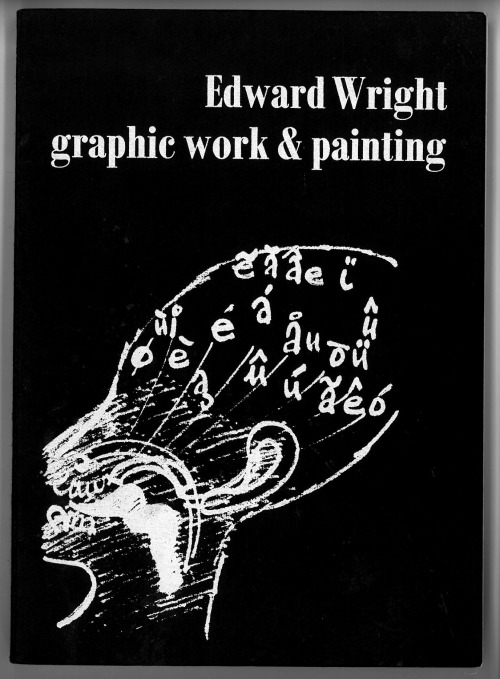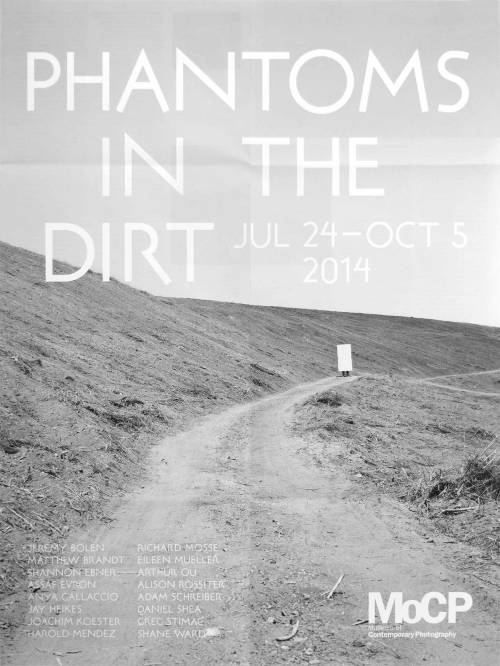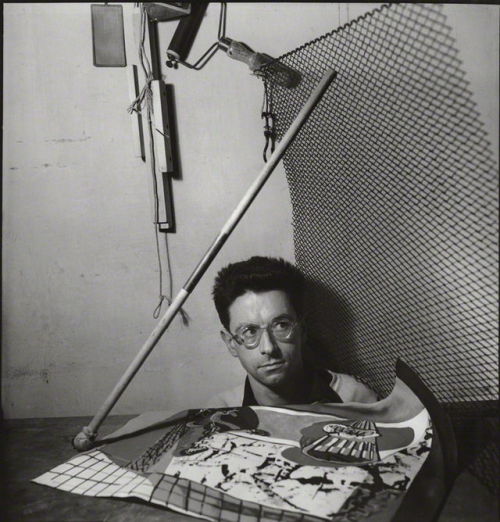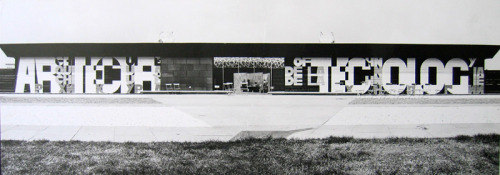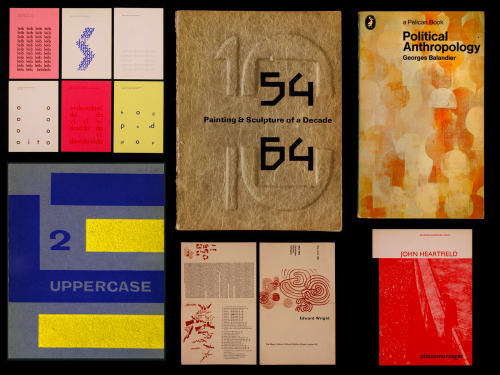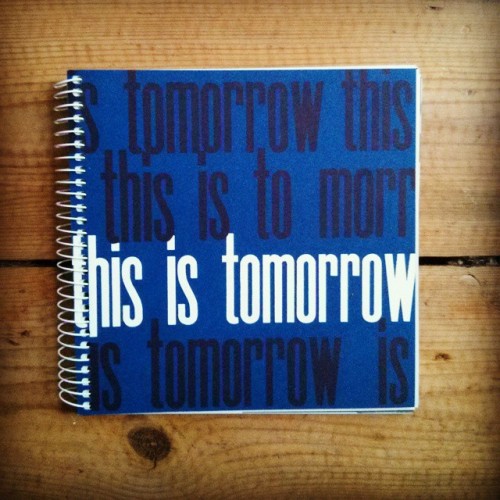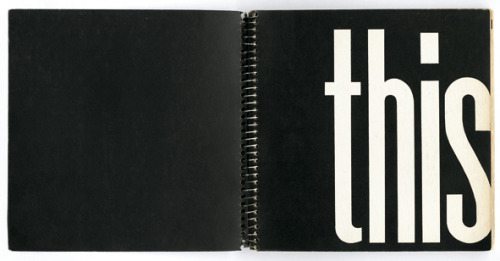#edward wright
Edward Wright graphic work & painting. Published by the Arts Council in 1985.
“The heart of the 20th century myth is the knowledge that each science, each activity is a part of all others” Edward Wright, 1960. This quote stood out to me in relation to the cross disciplinary set up of ‘This is Tomorrow’ and the various groundbreaking topics that it explored.
There is also a really interesting recollection by designer Trilokesh Mukherjee (who later worked for Ken Garland) about the lengths he had to go through to even get an interview for a place on Edward Wrights graphic design course at Chelsea School of Art in 1963:
“After going through a test for life-drawing, two tests for the History of Art (three hour written, and an hour of slide-test) and a day-long test for graphic design, I was called for the interview.”
Post link
As a follow up to my last post about designer/artist Edward Wright here is one of his typefaces being used by a contemporary designer:
This poster from July 2014 was designed by James Goggin for an exhibition in Chicago.
‘James Goggin’s poster employs a newly digitised cut of British designer Edward Wright’s Flaxman typeface… famously known for its rotating role on the New Scotland Yard sign outside London’s Metropolitan Police headquarters’.
It’s really good to see one of his typefaces digitised and in use! Looks great on this poster. Eagle-eyed readers may have noticed I’ve been using type inspired by Wright, but more on that soon…
Post link
Edward Wright - Designer, typographer, artist, writer, architect, teacher (1912–88)
Since the book I’ve ordered about Wright (published in 1985) hasn’t turned up yet, i’ll have to make to do with posting Hyphen Press’ bio. They published a book about him in 2007 which I sadly haven’t been able to track down.
“Edward Wright (1912–88) was an artist and designer. Born in Liverpool, where his father was Ecuadorian vice-consul (his mother was Chilean), he trained and worked briefly as an architect before concentrating on painting, drawing, print-making, and also ‘commercial art’ (as it was then still called). From 1942 through to his retirement he lived in London, with periods of work in book publishing and advertising, and teaching graphic design (very broadly conceived) – most notably at the Central School (his evening classes in typography, 1952–6, became legendary) and at Chelsea School of Art. Wright was among those who fostered the modern spirit in Britain, working alongside architects, and refusing any simple split between art and design. He was always much concerned with text and language. Among his exceptional work is the lettering that he made for modern buildings, often managing both a specific design and an alphabet that could be applied more generally.”
The best online source for info about Edward Wright is ‘The optimism of modernity’ which was a 2007 project from the Reading University typography department about modern British typography. One of their pages includes some great quotes about Wright from those who knew him, as both students and/or friends, including this one from Richard Hollis which is very revealing and touches on the ‘This Is Tomorrow’ work from my previous two posts.
“He was a great dancer, in a Latin American way. He and his improbable wife Kitty gave great parties. And generally, Edward was very un-English and exotic in a time of drabness – around 1960. He had all-over short hair, very unusual. His cultural references were almost entirely to things outside this country and his work was unlike what others were doing. He wasn’t really a designer – design was just one of his interests, just one of the skills he practised. His ‘This is tomorrow’ catalogue had no precedent and no direct influence. But it is one of the most memorable pieces of design made here.” - Richard Hollis
There is something very intriguing about his work, it is almost unsettling at times and can be hard to place. This definitely comes from his position as a relative outsider, which goes in part to explain why he is not better known (despite many friends and ex-students who are still big names). In the face of his unfortunate obscurity I’m really glad to have come across him and his work through an interest in 'This is Tomorrow’.
It just so happens there is a lecture about his lettering work in London next month: http://www.letterexchange.org/events/lx-lecture-david-pearson-designer-teacher/ hopefully I’ll make it there to find out more.
Portrait of Edward Wright via NPG all other images from Optimism-Modernity
Post link
Here begins the first of a few posts leading up to something more lengthy that I have been working on lately:
I first came across a significant mention of the 1956 Whitechapel gallery exhibition ‘This is Tomorrow’ through something I was researching outside of my usual sphere of graphic design. I suspect I had heard of it at some point previously in my arts education (perhaps not though) being as it is a seminal moment in British art. After a bit more digging what struck me most was the exhibitions catalogues design. I would have been hard pressed to place it as coming out of fifties Britain had I not known its context when seeing it for the first time. It gets a very fleeting mention in Richard Hollis’ 'Graphic Design: A Concise History’ sandwiched between mentions of Twen magazine and a little bit about First Things First -
“Images in magazines, which had been the raw material of Dadaist collages and 'mass communications’ in general, were attracting the attention of artists during this period. This interest was vividly expressed in the exhibition 'This is Tomorrow’ at the Whitechapel Art Gallery in London in 1956. The catalogue was designed by Edward Wright, who had been adept in the advertising manner of Elfer at Crawfords. The catalogue cover carried very condensed poster type printed by silkscreen, and its spiral-bound pages were among the first to use cheap offset lithography and type reproduced from typewriting. It looked forward to the do-it-yourself improvisations of the 'alternative’ magazines of the 1960s and represented the beginnings of Pop Art in the collages by Richard Hamilton” (p165)
Edward Wright was a new name to me, one I’d never seen mentioned in any books (as far as I remember), except for the aforementioned Hollis’. Biographical details and further examples of his work have proven fairly sparse online, beyond a few sources and articles. He is a surprisingly and unjustifiably obscure designer considering his typographic evening classes at the Central School were attended by future Pentagram co-founders Alan Fletcher, Colin Forbes and Theo Crosby, along with many other prominent names in graphic design history such as Ken Garland, Germano Facetti and Derek Birdsall. Quite a legacy… But I will say more about Wright and his work another time.
A facsimile reprint of the 'This is Tomorrow’ catalogue (worked up by one of my favorite contemporary designers - Fraser Muggeridge) is available from the Whitechapel Gallery, or if you are feeling rich you can get the original for a whopping £1,500 http://www.peterharrington.co.uk/rare-books/architectural/this-is-tomorrow/. Just another thing to naively and optimistically look out for in used bookshops I suppose…
(Spread images via Optimism Modernity)
Post link

Edward Wright - Dialectal D (1969)

